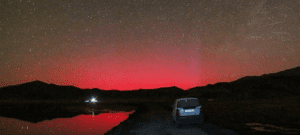TAG: GS 1: GEOGRAPHY
THE CONTEXT: Recently, the night sky was lit up by northern lights, or aurora borealis, at Hanle village in Ladakh. Northern lights were also witnessed in other parts of the world, including in the United States and the United Kingdom. Meanwhile, southern lights, or aurora australis, were spotted in countries such as New Zealand and Australia.
EXPLANATION:
- The recent visibility of auroras in various parts of the world was triggered by a coronal mass ejection (CME) from the Sun, resulting in a geomagnetic storm classified as “extreme” by National Oceanic and Atmospheric Administration (NOAA).
- NOAA forecasts the possibility of additional CMEs impacting the Earth in the coming days, emphasizing the importance of monitoring and preparedness for potential geomagnetic disturbances.
What Are Auroras?
- Auroras, also known as the northern and southern lights (aurora borealis and aurora australis respectively), are natural phenomena characterized by luminous displays in the night sky, typically observed near the Earth’s polar regions.
- These mesmerizing displays manifest as vibrant curtains of light, exhibiting hues ranging from blue and green to red and purple.
- Auroras result from interactions between charged particles from the Sun and the Earth’s atmosphere.
- These charged particles, primarily electrons and protons, are emitted by the Sun as part of the solar wind.
- When they reach the Earth, they are guided by the planet’s magnetic field towards the polar regions.

A rare red-coloured aurora, observed at the Hanle Dark Sky Reserve, in Ladakh
Level of geomagnetic activity:
- Geomagnetic activity is driven by solar activity and solar coronal holes and thus it waxes and wanes with time.
- The level of geomagnetic activity is indicated by the planetary K index or Kp.
- The Kp index ranges from 0 to 9.
- For Kp in the range 0 to 2, the aurora will be far north, quite dim in intensity, and not very active.
- For Kp in the range of 3 to 5, the aurora will move further from the poles, it will become brighter and there will be more auroral activity (motion and formations). If you are in the right place, these aurora can be quite pleasing to look at.
- For Kp in the range 6 to 7, the aurora will move even further from the poles and will become quite bright and active. At this geomagnetic activity level, it might be possible to see the aurora from the northern edge of the United States.
- For Kp in the range 8 to 9, the aurora will move even further towards the equator and it will become very bright and very active. These are the events that create the best aurora and the extended auroral oval will be observable by the most people. At these levels, aurora may be seen directly overhead from the northern states of the USA.
Mechanism of Auroras
- The Sun continuously emits a stream of charged particles known as the solar wind.
- When this solar wind encounters the Earth’s magnetic field, it gets deflected towards the poles.
- Some of these charged particles become trapped in the Earth’s magnetic field and are channelled towards the polar regions along magnetic field lines.
- As these charged particles enter the Earth’s atmosphere near the poles, they collide with atmospheric gases, predominantly oxygen and nitrogen.
- These collisions result in the excitation of oxygen and nitrogen atoms, causing them to emit photons of light.
- The specific colours observed depend on the type of gas and the altitude at which the collisions occur.
Colour Spectrum of Auroras
- Green Light: Collisions with oxygen atoms typically produce a greenish hue.
- Blue and Purple: Interactions with nitrogen molecules lead to the emission of blue and purple hues.
- Red and Yellow: Occasional sightings of red and yellow auroras can occur due to interactions with other atmospheric gases.
Factors Influencing Auroral Activity
- Solar Activity:
- Auroras are closely tied to solar activity, particularly solar flares and coronal mass ejections (CMEs).
- During heightened solar activity, increased solar wind intensity can trigger geomagnetic storms, enhancing auroral displays.
- Geomagnetic Storms:
- Intense disturbances in the Earth’s magnetic field, known as geomagnetic storms, can expand auroras from polar regions to lower latitudes, making them visible in mid-latitudes.
Impact of Geomagnetic Storms
- Technological Disruptions:
- Geomagnetic storms can disrupt satellite communications, GPS systems, and power grids, posing challenges to various technological and communication systems.
- Space Exploration Considerations:
- Astronaut safety and space exploration missions may be impacted by geomagnetic storms, requiring careful monitoring and adaptation of space-dependent operations.

